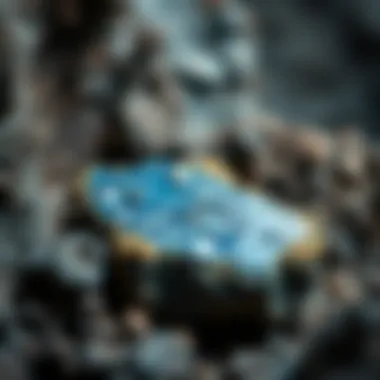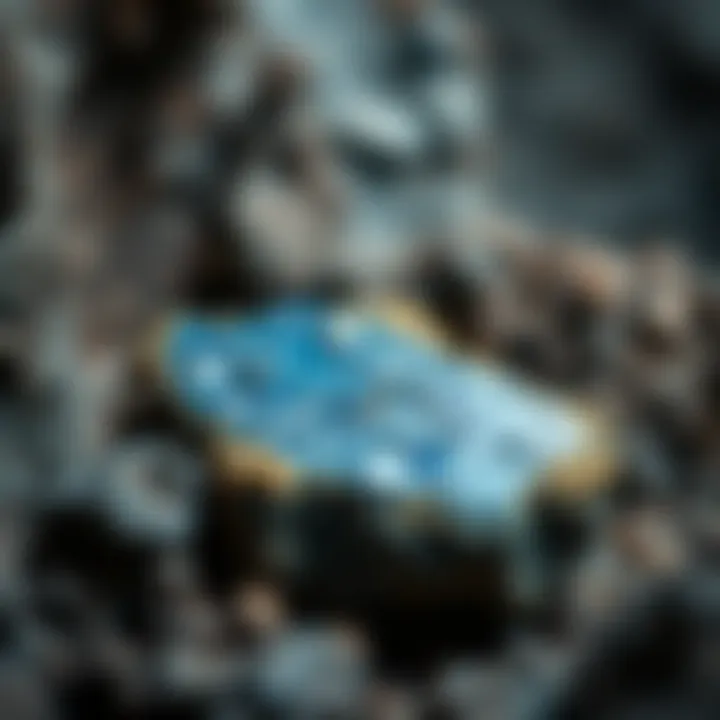Exploring the Rich Heritage of Lapis Lazuli


Intro
Lapis lazuli, a striking gemstone known for its brilliant blue hue, has not only captivated the hearts of artisans and collectors alike but also carries a weighty history that intertwines with several civilizations. This deep-blue metamorphic rock, made up mostly of lazurite, also contains calcite, sodalite, and pyrite, giving it a unique appearance that set it apart in the realms of art and adornment.
This article seeks to explore lapis lazuli’s past, its importance over the ages, and how it came to symbolize a bridge between the earth and the celestial, influencing cultures from ancient Mesopotamia to contemporary art scenes. Also to be examined are more than just its aesthetic qualities. The geological processes that give rise to this stone will be unraveled, revealing the nature of its formation. Understanding lapis lazuli proper involves looking at how it is identified, and the different classifications that exist, to aid both seasoned geologists and budding rock collectors in their pursuits.
So, let's embark on this journey through time and explore the multifaceted world of lapis lazuli.
History and Origins
A Peek Into the Past
Lapis lazuli has been revered for millennia, with its first known use dating back to the ancient civilizations of the Near East. The stone made its debut as early as 4,000 BC in the artifacts and art of the Sumerians. It was particularly prized in ancient Egypt, where it adorned the burial masks of pharaohs and was ground into powder for the brilliant ultramarine pigment used in painting, seen in tombs and sacred spaces.
"Lapis was more than just a stone; it was a symbol of royalty and divinity."
During the medieval period, lapis lazuli was exported along trade routes to Europe. Artists like Michelangelo began to use it for their masterpieces, reinforcing the connection between this stone and high art. Its presence in the cultural narrative demonstrates how lapis lazuli has transitioned from an ornamental object to a respected component in artistic expression, treasured by various cultures around the globe.
Gathering Stones of Stories
The way lapis lazuli is formed adds another layer of intrigue to its history. Deep beneath the Earth's surface, high-pressure and high-temperature conditions allow for the metamorphism of precise minerals over eons, resulting in the vivid blue stone we admire today. These geological processes not only yield lapis lazuli but also create a plethora of other minerals and rocks that tell their own stories.
Cultural Significance
In various cultures, lapis lazuli has been woven deeply into the fabric of mythology and superstition. It has been considered a protective stone believed to ward off evil and bring about harmony. The Persians associated it with royalty, while others believed it was a means to connect with the divine. Today, lapis lazuli serves both decorative and emotional roles, functioning as symbols of tranquility and enlightenment, reaching well beyond its geological identity.
This blend of natural beauty and cultural resonance makes lapis lazuli a gemstone of profound significance. It is not just a collector’s gem but a story-teller, carrying with it echoes of the past and whispers of human aspiration and creativity.
Prelims to Lapis Lazuli
Lapis lazuli stands as one of the most beguiling stones in the realm of geology and jewelry. This captivating blue gem has a history intertwined with human civilization, dating thousands of years back. It’s not just a pretty rock; its vibrant hue has largely influenced artistic expression, signifying status and spirituality in various cultures.
Understanding what sets lapis lazuli apart is critical for collectors and enthusiasts alike. Beyond its aesthetic allure, this stone carries a wealth of characteristics, each telling its own story. For instance, the deep blue color is indicative of its mineral composition, primarily lazurite, accompanied by specks of gold-like pyrite, which add to its richness.
But why should you care about lapis lazuli? For rock and fossil collectors, it’s not merely a matter of beauty. The importance lies in the historical significance, cultural ties, and geological origins of this stone. Knowing these facets elevates appreciation from a surface level to a much deeper understanding.
In this section, we’ll explore the key characteristics and historical importance of lapis lazuli, effectively laying the groundwork for the subsequent exploration of its geological formation and cultural impact.
A journey into this stone reveals not merely its physical attributes, but also a connection across time and space, reflecting the values and artistry of those who have cherished it throughout history.
Definition and Characteristics
Lapis lazuli is defined as a deep blue metamorphic rock predominantly found in Afghanistan, though it has made appearances worldwide. The gemstone primarily consists of lazurite, with calcite, sodalite, and often inclusions of pyrite contributing to its unique aesthetic.
The most striking characteristic of lapis lazuli is its rich blue coloration, which can vary from intense, almost royal hues to softer, dustier shades. The contrast of pyrite flecks shimmering across its surface often evokes images of a starry night, enhancing its value as a decorative stone.
When observing lapis lazuli, keep an eye out for the smoothness and polish of its finish. A high-quality piece will appear vibrant and evenly colored without too many visible inclusions. Here are a few key characteristics worth noting:
- Color: Vivid blue, with variations ranging from light to dark shades.
- Inclusions: Pyrite speckles can be present.
- Finish: A smooth, polished surface indicates higher quality.
These defining features make lapis lazuli a sought-after material, cherished both for its beauty and historical significance.
Historical Significance
Lapis lazuli has a storied history that can be traced back to ancient civilizations. In cultures around the world, this stone has been considered a symbol of power, spirituality, and wisdom. For instance, the Ancient Egyptians utilized lapis lazuli in their burial artifacts, believing it had protective properties for the afterlife. It often adorned jewelry worn by elite members of society to signify their rank.
In Mesopotamia, lapis lazuli was ground into powder for use in pigments, illustrating not only its value as a gem but also its practical applications in art and culture. Sumerian artifacts have showcased lapis lazuli pieces dating back to 3000 BCE, and it was also highly prized in the Indus Valley civilization as a sign of prosperity.
The stone's appeal transcended geographic boundaries; it was traded along the famed Silk Road, spreading not just across eastern and western cultures, but also influencing art, religion, and belief systems.
Today, lapis lazuli's historical significance serves as a bridge connecting us to our ancestors and their civilizations. As you delve deeper into the nuances of lapis lazuli, remember that you're engaging with a piece of history that has been valued for millennia.
Geological Formation
Understanding the geological formation of lapis lazuli is essential to appreciating its beauty and historical significance. This section dives into the mineral makeup, processes that shape it, and where it can be found around the globe. Each aspect has implications on the quality and value of this captivating blue gemstone, which has mesmerized cultures for thousands of years.
Mineral Composition


Lapis lazuli is primarily composed of lazurite, which gives it that rich blue hue. But this stone is not just a single mineral; it’s a mix. In fact, it contains calcite, pyrite, and sodalite. The presence of these minerals contributes both to its aesthetic and its overall properties.
- Lazurite: The star of the show, responsible for the deep blue coloration.
- Calcite: Often appears as white veining, providing contrast.
- Pyrite: Known as "fool’s gold," it adds a touch of sparkle, enhancing the stone’s appeal.
The right blend of these minerals is crucial; for instance, a lapis lazuli with high lazurite content and minimal calcite is often valued higher due to its striking color and visual uniformity.
Formation Processes
The journey of lapis lazuli begins deep within the Earth’s crust. It forms under specific conditions that include high-pressure and high-temperature environments, typically found in metamorphic rocks. As sedimentary rocks undergo metamorphosis due to tectonic pressures, the unique combination of minerals crystallize into this remarkable stone.
There are two primary factors that influence the formation:
- Geological Activity: Plate tectonics play a critical role, especially where oceanic and continental plates meet. These regions often create the conditions necessary for the concentration of the minerals mentioned earlier.
- Hydrothermal Processes: Hot water solutions seep through fissures in the rock, enriching the mineral deposits and allowing them to crystallize into lapis lazuli.
It’s fascinating to consider that while lapis lazuli can take millions of years to form, we often encounter it polished for jewelry or display within a short span of time.
Global Occurrences
Lapis lazuli isn’t just rare; its deposits are geographically specific, with four primary locations known for yielding high-quality stones. Each of these places not only contributes to the stone's character but also marks its different cultural significance on the world stage.
Afghanistan
Afghanistan is often regarded as the crown jewel in the production of lapis lazuli. The country's deposits, particularly those from the Badakhshan region, are renowned for their deep azure hues, often speckled with flecks of pyrite. This area's historical significance dates back to antiquity, where lapis lazuli was traded along ancient Silk Road routes.
The geological richness of Afghanistan makes it a premium source, although the mining conditions can be challenging due to the rugged terrain and political issues surrounding it. This uniqueness adds an aura of mystique and cultural value to the stones sourced from this region.
Chile
Situated in the heart of South America, Chile hosts some lesser-known but notable deposits of lapis lazuli, particularly in the Andes mountain range. The stones found here tend to display vibrant blues but may include more greenish hues than the Afghani varieties.
The accessibility of these deposits has made Chile an exciting alternative for lapis collectors. However, the stones may lack the rich history and traditional cachet that those from Afghanistan carry, meaning they can sometimes be overshadowed in the market.
Russia
In Russia, especially in regions like Siberia, lapis lazuli also surfaces, although primarily at smaller scales compared to Afghanistan and Chile. Russian lapis lazuli can occasionally exhibit unique characteristics, such as varied patterns due to its different geological setting.
The relatively recent discovery of these deposits allows collectors to find distinctive pieces, yet the volume is not enough to establish it prominently in the jewelry market like its more popular rivals.
United States
The United States contributes to the tapestry of lapis lazuli sources as well, with deposits found in places like California and Colorado. Though smaller, these mines have produced striking specimens that sometimes catch the eye of local collectors.
This availability makes U.S. lapis lazuli a more accessible option for those just starting in the field, though the pieces may not hold the same value or recognition as those from more storied origins.
Cultural and Historical Context
Lapis lazuli, a deep blue stone admired for its vibrant color and historical richness, serves not only as a material for decoration but also as a conduit of cultural expression through the ages. Delving into its cultural and historical context reveals the critical roles lapis lazuli played in ancient communities, and how it continues to influence contemporary art and symbolism today.
Usage in Ancient Civilizations
Mesopotamia
Mesopotamia, often hailed as the cradle of civilization, saw lapis lazuli as a precious commodity. It was used extensively in ornamentation and signified wealth and power. The ruling class adorned themselves with lapis lazuli jewelry, while its powdered form was utilized as a pigment in ancient art. A notable characteristic of Mesopotamian lapis lazuli is its usage in amulets, which were believed to bring protection and guidance to their wearers. The unique feature of this stone in Mesopotamian culture reflects both their spiritual beliefs and the social hierarchy, serving as a clear indicator of status.
Egypt
In ancient Egypt, lapis lazuli was more than just a decorative stone; it was steeped in symbolism, commonly associated with royalty and the divine. Pharaohs would frequently be buried with lapis lazuli artifacts, believing they would aid the transition into the afterlife. The deep blue of the stone was thought to represent the night sky, connecting pharaohs with the gods. Its distinct attribute in ancient Egypt is that it was often carved into scarabs and other symbols of protection, showcasing its multifaceted significance. This made lapis lazuli not only a luxury item but also a spiritual tool, reinforcing its importance as a resource in theological and mortuary contexts.
Indus Valley
The Indus Valley civilization also embraced lapis lazuli, integrating it into their craftsmanship. Archaeological findings reveal beautifully crafted lapis lazuli beads and seals, indicating a sophisticated understanding of trade and artistry. Key to the Indus Valley's use of lapis lazuli was its representation of trade networks. This stone, often originating from distant lands, illustrates the valley's connections to the broader ancient world. The unique feature of lapis lazuli artifacts from this region is their intricate designs, emphasizing precision and skill in craftsmanship. This highlights the Indus Valley’s cultural significance as a hub of innovation and trade during its time.
Symbolism and Beliefs
Lapis lazuli holds deep symbolic meaning across various cultures. It is often associated with wisdom, loyalty, and the heavens. In many traditions, the stone is believed to enhance one’s intuitive abilities, supporting mental clarity and self-awareness. Its captivating hue draws parallels with the sky and sea, symbolizing depth and harmony. In spiritual practices, it is thought to open the Third Eye chakra, thereby fostering enlightenment.


Impact on Art and Literature
Medieval Manuscripts
During the Medieval period, lapis lazuli found its way into manuscripts, where it was ground into ultramarine pigment. This pigment became a staple for artists seeking the vibrant blues that could elevate religious depictions. The use of lapis lazuli in this context is significant as it represented not only artistic beauty but also the high cost that came with achieving such brilliant color. Many illuminated texts featured this luxurious pigment, underscoring the financial and artistic investment of medieval artisans.
Renaissance Art
As the Renaissance unfolded, lapis lazuli continued to grace the palettes of world-renowned artists. It was a coveted material, often reserved for the most important works. Its rarity ensured that only the wealthiest patrons could afford it, bestowing extra value on artworks. The deep blue of lapis lazuli became synonymous with divinity in paintings, illustrating its ongoing importance in iconography and aesthetics.
Modern Interpretations
In contemporary art, lapis lazuli has regained attention, being incorporated into various artistic forms. Artists today interpret its historical significance through different mediums, combining modern techniques with ancient traditions. Lapis lazuli still represents a bridge between the past and present, offering artists a canvas of rich cultural heritage. It serves as both a reminder of historical practices and an inspiration for innovative expression.
Lapis lazuli stands as a testament to the enduring beauty and significance of natural materials across time, embodying the intersection of art, spirituality, and cultural exchange.
Through its historical journey, lapis lazuli continues to be cherished in both collections and modern interpretations, showcasing its timeless allure and complex significance.
Lapis Lazuli in Jewelry and Ornamentation
The appeal of lapis lazuli in the context of jewelry and ornamentation goes beyond its vivid blue hue. This semi-precious stone has made waves in various cultures and eras, shining brightly in both the aesthetic and practical realms of artistry. Lapis lazuli not only serves as a jewel but also tells stories of ancient craftsmanship and passionate devotion. The unique properties of this stone make it an essential choice for artisans and collectors alike, blending tradition with modern sensibility in the world of adornment.
Crafting Techniques
Slicing and Polishing
Slicing and polishing lapis lazuli is a fundamental technique in its transformational journey into jewelry. It involves cutting the stone to achieve specific shapes, followed by meticulous polishing to bring out the mesmerizing luster. This process is crucial because it enhances the natural beauty of lapis lazuli while preserving its unique characteristics. The deep, celestial blues can be highlighted, revealing gold flecks of pyrite embedded within it. This specific aspect makes slicing and polishing not just practical, but almost artful, resulting in pieces that captivate and inspire.
One key characteristic of this technique is the ability to create smooth, shiny surfaces that are desirable in jewelry. It allows for a wide array of designs, from simple pendants to complex inlaid pieces. While the advantages are clear, slicing and polishing can present challenges. For instance, if not done properly, it might lead to scratches or damage to the stone, which can diminish its aesthetic appeal. Careful handling and skilled artisanship become paramount in the process, ensuring that each piece remains a tribute to this remarkable stone.
Inlaying Techniques
Inlaying techniques represent another dimension of crafting lapis lazuli into jewelry. This method involves embedding lapis lazuli pieces into a base material, often wood or metal, to create intricate designs that stand out. The way lapis lazuli can be cut into precise shapes allows for remarkable detail in pieces, making inlaying techniques a favored choice for creating striking compositions.
A prominent feature of inlaying is the capacity for mixed media, where lapis lazuli can dance with other materials, such as mother-of-pearl or silver. This results in visual storytelling within the object, blending cultures and artistic styles. However, one must also consider the drawbacks; inlaying can be labor-intensive, requiring higher craftsmanship skills, which can inflate costs. Yet, the allure of unique, handcrafted pieces often outweighs these considerations for enthusiasts devoted to quality and artistry.
Market Trends and Styles
The landscape of lapis lazuli jewelry is constantly evolving. Keeping an eye on market trends and styles proves essential for collectors and creators. This vivid stone maintains a revered status, yet contemporary interpretations and vintage flair find their way into many collections.
Contemporary Jewelry
Recent trends show a surge in contemporary jewelry pieces that skillfully blend traditional lapis lazuli with modern design sensibilities. The simplicity and minimalism of these contemporary styles often make use of fine lines and geometric shapes, allowing the color of the stone to shine without distraction. The key characteristic of this trend is its versatility; lapis jewelry can easily transition from casual wear to formal occasions. Marketers often highlight this adaptability, making contemporary lapis lazuli jewelry an appealing investment.
One unique feature that stands out in this genre is the combination of lapis lazuli with modern synthetic materials, a fusion that brings in fresh perspectives. However, while contemporary pieces often attract new collectors, discerning buyers need to be cautious of the authenticity of materials used.
Vintage and Antique Pieces
On the flip side, vintage and antique lapis lazuli pieces carry their own charm and historical significance. Often crafted with artistry that reflects the era, these pieces tell stories of past generations. Collectors find it fascinating to explore the craftsmanship from days gone by, which makes vintage and antique pieces not only beautiful but also a valuable link to history.
The key characteristic of these items is their uniqueness—each piece is crafted with intentionality, often showcasing intricate detailing that is often lost in modern mass production. Collectors are drawn to the notion of wearing history, although one must be aware of the condition and any restoration done on these pieces to ascertain their true value. These elements contribute significantly to the allure that vintage lapis lazuli jewelry exudes, creating a cohesive market rich in both aesthetic and historical significance.
Lapis lazuli is not just a gemstone; it’s a bridge between cultures, eras, and artistic expressions—woven together through the art of jewelry making.
Scientific and Healing Properties
Lapis lazuli holds a significant place in the world of both geology and metaphysics. For collectors and enthusiasts, understanding its properties can enhance appreciation and care of this unique stone. This section dives into two primary facets: the metaphysical beliefs surrounding lapis lazuli and relevant scientific studies that illustrate its properties.
Metaphysical Beliefs
Among many cultures throughout history, lapis lazuli has been attributed various metaphysical properties. It is often considered a stone of wisdom, encouraging self-awareness and self-expression. Many people believe it aids in the pursuit of truth, making it a popular choice for those seeking clarity in thought and communication.
Some of the key beliefs associated with lapis lazuli include:
- Enhancing Intuition: Many users believe that wearing or carrying lapis lazuli helps sharpen their instincts and improve their decision-making abilities.
- Fostering Friendships: It is said to promote harmony in relationships, enhancing communication and understanding among friends and loved ones.
- Emotional Healing: Some proponents suggest that the stone assists in processing emotions, embedding a sense of calming energy that can alleviate stress.


These beliefs are often rooted in ancient civilizations like the Egyptians, who used lapis in their jewelry and artifacts not just for beauty but also for the perceived metaphysical benefits. The stone’s rich blue color was thought to represent the night sky, linking it to celestial ideals and divine knowledge.
Scientific Studies
While metaphysical properties are fascinating, scientific inquiry into lapis lazuli also warrants attention. The gemstone primarily consists of lazurite, with accompanying minerals such as calcite and pyrite. Understanding this composition provides insights into its formation and qualities.
Research into lapis lazuli has revealed several scientific aspects that highlight its uniqueness:
- Mineral Structure: The specific crystalline structure of lazurite gives lapis lazuli its brilliant color. The presence of sulfur in the mineral composition contributes to its deep blue hue, which can vary significantly based on the concentration of additional minerals.
- Uses in Modern Science: Recent studies have explored the application of lapis lazuli in a variety of fields, including materials science and art conservation. Its striking appearance and durability make it a topic of interest for creating sustainable pigments in art materials.
- Geological Significance: Lapis lazuli's occurrence primarily in metamorphic rocks sparks interest among geologists. It serves as an insightful indicator of specific geological processes that have taken place over millions of years.
This dual lens of metaphysical beliefs and scientific inquiry enriches the narrative surrounding lapis lazuli, allowing for a comprehensive understanding of the stone’s role in both history and modern application.
Collecting Lapis Lazuli
The world of lapis lazuli collection offers a unique glimpse into the confluence of nature, art, and history. Collectors are drawn to this stone not only for its breathtaking azure hue but also for its multi-dimensional significance and the stories it carries from ancient trade routes to modern jewelry showcases. Owning a piece of lapis lazuli connects individuals to a rich cultural heritage and provides both aesthetic pleasure and potential investment value.
Identification and Verification
When it comes to collecting lapis lazuli, knowing how to effectively identify and verify its authenticity is crucial. Genuine lapis lazuli boasts a deep blue color, often flecked with golden pyrite, which resembles tiny stars in a night sky. The presence of calcite stains or white streaks can suggest lower quality or imitation stones.
To properly verify lapis lazuli:
- Check for inclusions: Look for the characteristic gold-speckled pyrite.
- Color depth assessment: Authentic stones typically display intense, saturated blues.
- Testing with light: Genuine lapis often appears opaque in natural light but may reveal subtle translucence in bright light.
Valuation Criteria
Valuing lapis lazuli involves intricate considerations that can determine a collector's choices.
Color Intensity
In the realm of lapis lazuli, color intensity plays a vital role in valuation. The richness of the blue shade defines a piece's desirability. A striking, uniform blue without excessive calcite or other inclusions is generally more sought after.
Key characteristics of color intensity include:
- Saturation and Uniformity: The deeper and more consistent the blue, the higher the value.
- Natural vs. Enhanced: Some stones might be treated, which can impact both appearance and price.
Unique features of color intensity: High-intensity colors can elevate the aesthetic appeal of jewelry, making it a popular choice for collectors seeking the best specimens. For those looking to invest, pieces with rich blue tones often fetch higher prices on the market.
Clarity and Finish
While color draws initial attention, clarity and finish influence the overall appeal and marketability of lapis lazuli. A well-finished and clear piece will better showcase its color and spark interest among collectors.
Key characteristics include:
- Surface Smoothness: A polished finish enhances the visual effects of the stone, making it more desirable.
- Presence of Inclusions: Lower clarity due to heavy inclusions can diminish aesthetic value.
Unique features of clarity and finish: Higher clarity is beneficial as clear stones are generally easier to mount in jewelry settings, attracting buyers who value quality craftsmanship.
Preservation Techniques
To maintain the beauty and integrity of lapis lazuli pieces in a collection, proper preservation techniques are essential. Here are some effective practices to follow:
- Avoid Direct Sunlight: Prolonged exposure to sunlight can fade the intense blue color over time.
- Store in Soft Fabric Pouches: Keeping them in soft, breathable materials prevents scratches.
- Regular Cleaning: Use a soft cloth to gently wipe dust and smudges. Avoid chemicals, as they can damage the stone.
Ending
In the realm of geology, understanding the formation and global occurrences of lapis lazuli provides collectors with insights into its rarity and value. The various crafting techniques have not only preserved its allure but have also allowed artisans throughout the ages to express creativity and skill. Moreover, exploring its metaphysical beliefs and scientific backing adds layers to its appeal, making it a focal point for both enthusiasts and casual admirers alike.
"Lapis lazuli is not simply a stone; it's a wellspring of history and culture, a connection to ancient traditions that speaks to our modern sensibilities."
A meticulous approach to valuation and preservation is crucial for collectors. Knowledge about the criteria for identification and what factors influence market trends can empower enthusiasts to make informed decisions. Understanding the significance of color intensity and clarity will enhance appreciation for the stone and elevate collecting to an art form.
Summary of Key Points
- Historical Significance: Lapis lazuli was prized in ancient civilizations for its use in art, decoration, and thought to possess protective qualities.
- Geological Features: The formation, mineral composition, and global locations contribute to understanding its rarity and market value.
- Cultural Impact: Its use spans various forms of art and jewelry, influencing styles across centuries.
- Collecting Insights: Knowledge about preservation, identification, and valuation criteria is vital for serious collectors.
Future Outlook
As we gaze at the horizon, the future of lapis lazuli remains bright. The demand for natural gemstones that resonate with history and culture continues to grow. Increasing environmental awareness and ethical sourcing practices will likely shape how lapis lazuli is mined and distributed. Furthermore, advancements in technology may lead to more refined techniques in crafting and restoring pieces, ensuring that the legacy of this stone endures.
In addition, the journeys of lapis lazuli through time will likely inspire new generations of artists and collectors who appreciate the depth and significance of this blue gem. With ongoing studies into its properties and historical contexts, we can anticipate that lapis lazuli will capture the imagination and hearts of many more enthusiasts.
In short, lapis lazuli is more than an aesthetic choice; it is a vessel of stories, a link to the past, and a symbol of connection in an ever-evolving world.



